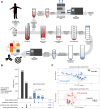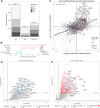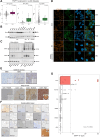Surface and Global Proteome Analyses Identify ENPP1 and Other Surface Proteins as Actionable Immunotherapeutic Targets in Ewing Sarcoma
- PMID: 37812652
- PMCID: PMC10905525
- DOI: 10.1158/1078-0432.CCR-23-2187
Surface and Global Proteome Analyses Identify ENPP1 and Other Surface Proteins as Actionable Immunotherapeutic Targets in Ewing Sarcoma
Abstract
Purpose: Ewing sarcoma is the second most common bone sarcoma in children, with 1 case per 1.5 million in the United States. Although the survival rate of patients diagnosed with localized disease is approximately 70%, this decreases to approximately 30% for patients with metastatic disease and only approximately 10% for treatment-refractory disease, which have not changed for decades. Therefore, new therapeutic strategies are urgently needed for metastatic and refractory Ewing sarcoma.
Experimental design: This study analyzed 19 unique Ewing sarcoma patient- or cell line-derived xenografts (from 14 primary and 5 metastatic specimens) using proteomics to identify surface proteins for potential immunotherapeutic targeting. Plasma membranes were enriched using density gradient ultracentrifugation and compared with a reference standard of 12 immortalized non-Ewing sarcoma cell lines prepared in a similar manner. In parallel, global proteome analysis was carried out on each model to complement the surfaceome data. All models were analyzed by Tandem Mass Tags-based mass spectrometry to quantify identified proteins.
Results: The surfaceome and global proteome analyses identified 1,131 and 1,030 annotated surface proteins, respectively. Among surface proteins identified, both approaches identified known Ewing sarcoma-associated proteins, including IL1RAP, CD99, STEAP1, and ADGRG2, and many new cell surface targets, including ENPP1 and CDH11. Robust staining of ENPP1 was demonstrated in Ewing sarcoma tumors compared with other childhood sarcomas and normal tissues.
Conclusions: Our comprehensive proteomic characterization of the Ewing sarcoma surfaceome provides a rich resource of surface-expressed proteins in Ewing sarcoma. This dataset provides the preclinical justification for exploration of targets such as ENPP1 for potential immunotherapeutic application in Ewing sarcoma. See related commentary by Bailey, p. 934.
©2023 The Authors; Published by the American Association for Cancer Research.
Figures




Comment in
-
Therapeutic Hope on the Surface of Ewing Sarcoma.Clin Cancer Res. 2024 Mar 1;30(5):934-936. doi: 10.1158/1078-0432.CCR-23-3138. Clin Cancer Res. 2024. PMID: 38113033 Free PMC article.
References
-
- Riggi N, Suvà ML, Stamenkovic I. Ewing's sarcoma. N Engl J Med 2021;384:154–64. - PubMed
-
- Delattre O, Zucman J, Plougastel B, Desmaze C, Melot T, Peter M, et al. . Gene fusion with an ETS DNA-binding domain caused by chromosome translocation in human tumours. Nature 1992;359:162–5. - PubMed
-
- Sorensen PH, Lessnick SL, Lopez-Terrada D, Liu XF, Triche TJ, Denny CT. A second Ewing's sarcoma translocation, t(21;22), fuses the EWS gene to another ETS-family transcription factor, ERG. Nat Genet 1994;6:146–51. - PubMed
-
- Grünewald TGP, Cidre-Aranaz F, Surdez D, Tomazou EM, de Álava E, Kovar H, et al. . Ewing sarcoma. Nat Rev Dis Primer 2018;4:5. - PubMed
Publication types
MeSH terms
Substances
Grants and funding
LinkOut - more resources
Full Text Sources
Medical
Miscellaneous

